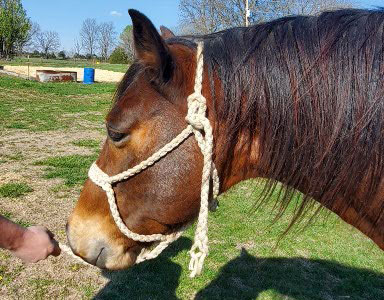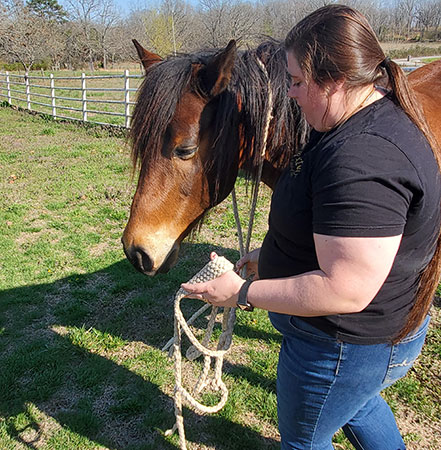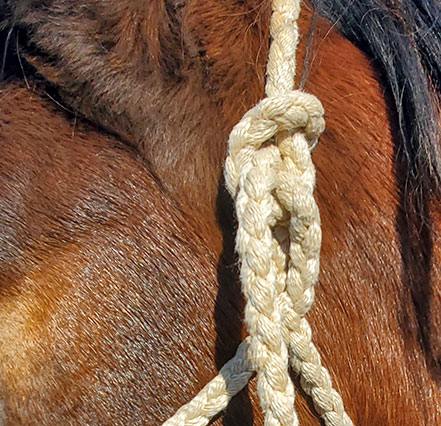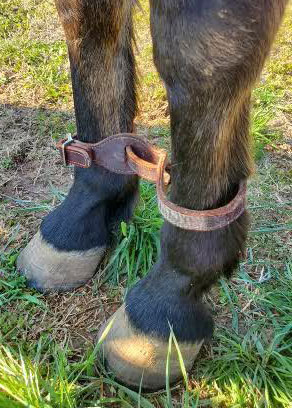

Halters are designed to help catch, hold, lead and tie horses and ponies. A rider may choose to have a specific halter for each horse, or they can select one of the correct size and adjust it to fit any horse (Figure 1). A correctly adjusted halter fits snuggly with the noseband two inches below the bony point of the horse’s cheek.
Halters come in a variety of styles, colors and materials including rope, nylon and leather. Handlers should be knowledgeable on the type of halter best suited for the horse and its job. For example, rope halters are great for everyday use because they are adjustable and can easily be interchanged between horses. They are also light weight and small enough so that there is little interference with the bridle while riding. Leather halters, however, have a more formal look and are more often used for shows or special occasions.
Types of halters
Rope halters
Rope halters are made of braided material, are strong, relatively inexpensive and easily adjustable. Most of today’s rope halters are made of braided synthetic fibers that do not shrink. Rope halters can be made from various materials such as nylon, cotton and poly. A problem with cotton rope halters is that they shrink with moisture.
Cattle rope halters pull tight under the jaw and over the top of the head and should only be used for horses in an emergency. A handler could also use a lariat rope if a horse halter is not available. Tie a knot at the point where the lead rope passes through the eye of the halter, and the lead rope becomes a halter shank.

Leather halters
Leather halters are available in a wide variety of types and prices. Some are adjustable only at the crownpiece, while others have an adjustable chin strap to accommodate various sizes of muzzles, as well as adjustments in the crownpiece to fit various lengths of heads. This type of halter is especially well adapted for use on young growing horses or where one halter is used on a number of horses. Leather halters are easily repaired, easiest to individualize with name plates, look dressier than other types of halters and in general, are more expensive.
Leather halters require a great deal of care to keep them in good condition. They must be cleaned regularly and inspected for wear or damage. Leather halters should be cleaned frequently with saddle soap or leather cleaner, but avoiding excess oil of any kind, even special leather oils. Too much oil makes the leather sticky, and will cause the halter to stretch and lose its strength. Oil will also rot the stitching. Oiling is necessary only when neglect has allowed the halter to dry out. New halters should be softened with saddle soap only.
Leather halters should not be allowed to remain damp, causing mildew. When not in use, leather halters should be cleaned and stored in a dry place, avoiding excess heat.
Nylon halters
Nylon halters are the most widely used today. Nylon halters should be cleaned with soap and water, thoroughly dried and stored in a dry area. They are easily cleaned, not usually affected by dampness, not subject to rotting and mildew, and can be obtained in a variety of colors and sizes. Nylon does not shrink; instead, it tends to stretch. In some cases, nylon halters tend to slip at the adjustment points, especially at the crown and under the chin. Therefore, it is necessary to occasionally readjust nylon halters.

Nylon halters are usually made in a flat web design. They are designed like leather halters, but cost less, last longer and require less care. Nylon halters can be purchased with many options such as adjustable chinpieces and rolled throatlatches. The downside to having extra snaps or buckles is that they create weak points. Often halters with cheek snaps break if the horse sets back.
Some halters have snaps at the cheek, so unbuckling is not needed when putting on or removing the halter. This type of halter does not work well on horses that dislike having their ears handled or tend to be head shy.


Horses should never be turned out with a nylon halter on, because of several safety concerns. Horses can get halters stuck on trees, fences or their hind limbs. If a horse needs to be turned out with a halter on, it is recommended to use a leather halter because it is more likely to break.

Halter sizing
Halters of all types may be purchased in various sizes. Most manufacturers list sizes according to breed, age, type, or weight. Depending on the type of halter and the retailer, measurements may vary. Designations of the breed type or age of horse are often used to identify sizes. These designations may be mini, pony, foal, yearling, cob, Arabian, horse, large horse, or draft. However, if purchasing online, exact measurements of the halter are often available to ensure the halter will fit the intended horse.
Haltering
Putting a halter on a horse is easy if the horse has good manners and has been properly trained. The horse should be trained to let a person approach on the horse’s left side.
To halter a horse in a corral, paddock or pasture, the horse first must be caught. A lead rope can be used to initially catch the horse. This is accomplished by placing the lead around the neck and holding both ends as a loop in the handler’s right hand (Figure 5). This procedure is especially recommended for head-shy horses or ponies that resist being haltered.



Carry the halter, unbuckled or unsnapped, in the left hand. The left hand can then slip the noseband of the halter over the nose while the right hand can grasp the crownpiece and put it in place by lifting the crownpiece strap over the poll and behind the ears. The final step is to secure the halter by fastening the buckle, snap, or tying a knot. Watch a step by step video on how to properly tie a rope halter.

In the case of halters with snaps at the cheek, it may be easier to use the left hand to push the halter back over the ears and use the right to fold the ears forward under the crownpiece.
Adjusting the halter
Once the halter is in place, it should be properly fitted, by adjusting the length of the crownpiece. This adjustment is determined by the position of the noseband. The noseband should fall about two inches below the bony point of the cheek (Figure 8).

If the noseband is too high, it may rub against the cheek, causing irritation and loss of hair. This will also cause the chinpiece to be pulled too high under the jaw and can restrict jaw movement. If the noseband is too low, it may allow the horse to rub the halter off too easily.
If the noseband and chin strap are adjustable, they should be set so that there is about a 2-inch gap under the noseband. Some halters may have an adjustment on both sides of the crownpiece. If so, both sides should be adjusted evenly to keep the halter balanced.
Halters should not be left on horses that will not be watched or that are being turned out. Halters can catch on anything like fences, tree branches or brush, and if the horse is unable to free itself, it may panic, which can have serious consequences. Horses use their rear feet to scratch their heads, and loose-fitting halters are an open invitation to get a back foot caught or "hung-up."
Tying the horse
There are no rules for tying a horse other than those dictated by safety. Tying is only a matter of keeping a horse in one place. Most horses learn to “tie” simply because they find it easier to stand quietly than to fight. All horses should be taught to stand tied and should not be considered fully trained until they do so.
The first requirement in correctly tying a horse is to use a knot that can be untied quickly, will not slip, and can be untied even though the horse may be pulling back on the tied rope. The recommended knot for tying a lead rope to a fixed object is a quick-release knot (Figure 9). a href="https://www.youtube.com/watch?v=lwEpVEpgRr4">Watch a video detailing how to safely tie a horse.

Take special care to prevent a horse from breaking loose when tied. Once a horse breaks loose, either from improperly tied knots or breakage of equipment, the horse is apt to try harder to break loose the next time it is tied. Halters, lead ropes and the objects to which they are to be tied should be strong and sound to minimize any chance of the horse breaking free. Horses should be tied to something solid and that will not give way to pressure if the horse would pull back.

Horses should be tied far enough apart so they cannot kick or bite each other. They should be separated by ropes, rails or distance. A recommended distance between strange horses when tied to a fence or along a picket line is 20 feet. At no time should they be tied closer than 10 feet apart.
Unless a horse is tied in a stall, it should not be left unobserved for long periods of time. This is particularly important with young horses. When possible, tie horses where they can watch activities around them. When tied this way, they are less likely to become bored or frightened. Horses should never be tied fast with bridle reins. Bridles are not designed to act as halters and reins are not intended to be used as lead ropes. Horses can break teeth or cut their tongue or mouth if they set back or get tangled in the reins and jerk their head while tied.
Tying to post
To tie a horse to a post, stake, smooth vertical pole or tree trunk, a combination knot may be used to prevent the rope from dropping down the pole and from slipping.

Tying a horse to a smooth horizontal pole or to a picket line can be safely done in a manner similar to the procedure used for a vertical pole. In this case, an additional wrap should be made in the hitch, followed by the quick-release knot, to keep everything in place.
Problem horses
Some horses dislike being tied and are known as halter pullers. To help prevent halter pulling or to get around this problem, a lariat rope may be placed around the girth of a horse with the standing part of the rope extending forward to the halter ring from between the front legs of the horse. The end of the lariat is then tied to a fixed object. As the horse backs up, the lariat loop tightens around the horse’s middle and the rope through the halter rings pulls the head down, without injuring the neck at the atlas joint. It usually takes only a few short sessions before the horse learns to stand quietly.
Hobbles


When there are no suitable objects to which a horse can be tied, it may be possible to use hobbles. This method might be useful on trail rides or when stopping in an open park or pasture. The horse must be trained to accept the hobbles, which is best done when the horse is first being trained by an experienced horse person in a round pen with soft ground. It should be noted that some horses can travel a fair distance when only the front legs are hobbled to each other.

Cross tying
Cross tying requires not only special equipment but also special training. Most horses object at first to having their heads held immobile. To start training, allow a lot of slack in both ties. Gradually shorten the ties until the desired control is obtained. It is usually advisable to allow 6 to 8 inches of play on each side of the center. One way of doing this is to leave the ties long enough to overlap the length of the snaps.
Resources
To find a complete list of publications, videos and other resources, visit the Equine Extension program.
- G2835 – Buying a Horse
- G2864 – Pre-Bit Hackamore Training
- G2870 – Tips for Pony Pleasure Drivers
- G2878 – Safe Ground Handling of Horses
- G2881 – Saddling, Bridling and Riding the Western Horse
- G2882 – Safety for Hunt Seat Riders
- G2883 – Intermediate Trail Riding
- G2884 – Community Pleasure Trail Riding
- G2885 – Trail Riding Checklist
- G2887 – Selecting a Saddle